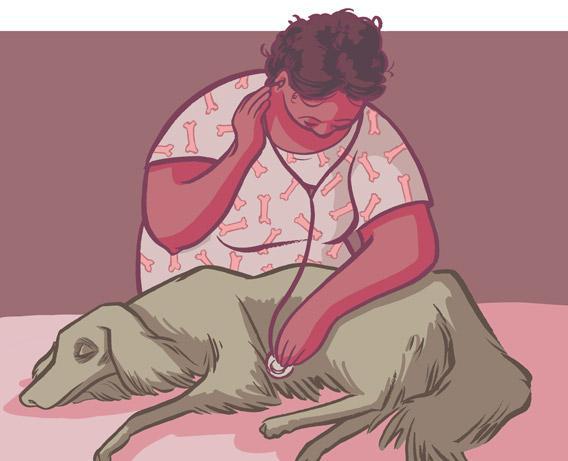Picture a hospice: walls painted soothing colors, landscapes hanging in the rooms, compassionate nurses at bedsides. And patients living out their last days in relative comfort—not at home, true, but also not in the cold, impersonal, constantly beeping confines of a hospital. With the patients are their dearest, constant companions, who are petting them gently, offering them bacon-flavored treats, rubbing their tummies. In this hospice, the patients are dogs.
It’s not that far-fetched a notion, according to animal bioethicist Jessica Pierce, whose thoughtful new book The Last Walk: Reflections on Our Pets at the End of Their Lives asks what a “humane” death for a pet should look like. The vast majority of pets in this country die by euthanization. But there are few rules—legal or moral—about the end of a pet’s life. We are charged with judging when “it’s time,” but what does that mean? And do we owe it to our pets, and by implication, ourselves, to try to provide them with an end that more closely mirrors our own?
Pierce asks these questions in chapters that are interspersed with a journal she kept during the last year of her dog Ody’s life. Watching Ody’s condition degenerate to the point where he can no longer walk was particularly difficult, because Ody’s demise almost exactly paralleled that of my own dog, Lee, whom I put down in November 2010. According to Pierce’s journal, it was in that same month that she finally faced the reality of Ody’s condition and had him euthanized.
Above all, though, Pierce wants to explore the question of what constitutes, for a pet, a “good death,” one that is
free of unnecessary pain, suffering, and fear; it is peaceful. And it takes place in the presence of compassionate witnesses. It is, above all, a death that is allowed its full meaning. Is it strange to say that we might desire for the death of an animal to be meaningful? Can the ultimate act of obliteration have meaning? Yes. It can and does.
Every dog owner—or at least, every decent one—asks herself at the end of her dog’s life whether she could have done more. More to prolong her dog’s life and more to ease her dog’s pain, but also more Beggin’ Strips and arthritis pills wrapped in salami. More petting. More licks. More snuggling.
The nature of survivor’s guilt is such that the answer is almost always yes—and Pierce seems to struggle with finding where this line is. It’s hard not to feel empathy with her—and yet, in her explorations of what it means to have done “as much” as she could have is a touch of the dog-person-martyr. After all, we are talking about an animal who, by Pierce’s own description, had trouble walking, was listless, pooped explosively in Pierce’s house almost every day, and was mostly deaf and blind. “One of the avenues I wish I had explored more carefully for Ody,” she writes, “are the nondrug therapeutic alternatives such as canine rehabilitation, physical therapy, massage, laser therapy, and acupuncture.” She writes matter-of-factly of dog wheelchairs, which she admits cost around $500, but that nonetheless allow a dog whose hindquarters are paralyzed to “walk, run, swim, pee, poop, and generally smell the roses.”
It was difficult, at first, for me to read Pierce’s words without thinking: I was a bad dog mom. In the last two weeks of Lee’s life, her back legs were paralyzed, and to walk her I had to lift up her back half—which was dead weight—in a sling, and try to get all 55 pounds of her downstairs without her peeing by the elevator in my building. But reading Ody’s story I had the fleeting thought that I should’ve bought Lee a wheelchair so she could have eked out, I don’t know, another few months of life.
But then I thought, hell no. Those last couple of weeks were terrible and trying, for both of us. She mostly stayed in the corner of my apartment. She barely ate. She seemed supremely bummed out, even though it was unclear whether she realized exactly what had happened to her. (Vet consensus was no.) So if I’d gotten her a dog wheelchair, maybe she would’ve been able to roll around for a little while longer, but her quality of life would’ve, frankly, sucked.
After Lee had her stroke, Pierce probably would have suggested that I evaluate Lee’s condition on the scale developed by a vet named Alice Villalobos, who is on staff at a Southern California pet hospice called Pawspice. (One of the enduring mysteries of life is why dogs, Thai restaurants, and hair salons inspire such terrible puns.) Pierce explains that Villalobos’ scale asks pet owners to evaluate their sick or elderly pets based on hurt, hunger, hydration, hygiene, happiness, and mobility on a 1-10 scale. A total score of 35 or more is acceptable, while under 35 “suggests that euthanasia may be the best option.” I considered Lee’s condition retroactively, and tallied a score of 19.
In Pierce’s view, merely making these considerations is a step in the right direction. Ideally, though, she seems to envision a world of animal palliative care that seems unrealistic to execute on a large scale and also prohibitively expensive—it is unlikely that most pet owners will, toward the end of their pets’ lives, provide them with hospice care. But what does seem possible is that a small minority of pet owners with the resources and desire to do so will begin to explore these new frontiers in animal aging, and will thus inspire changes for the rest of us. “Animal hospice broadens the possibilities and stimulates creative thinking about how our animals can die and what compassionate care can look like,” Pierce writes. “Hospice offers us a gentler way down into the Valley of Death, a slow path down that we can travel hand-in-paw with our animal rather than shoving them brusquely off a precipice.”

Author Jessica Pierce.
Courtesy of the author.
That’s inspiring, and I believe she’s right about what hospice care can accomplish. But this passage also illustrates one of the more frustrating aspects of The Last Walk: Pierce tends to think mostly in sentimental dichotomy, assuming that if we are not riding off “hand-in-paw” with our pets, then we are “shoving them brusquely off a precipice.” Like her own decision to finally euthanize Ody, though, it’s clear that for most pet owners, there’s less brusque shoving than heart-wrenching decisions made, more often than not, out of love. I was standing in the hallway outside my office when the vet told me gently that my options for Lee were running out—she’d failed to respond to the steroids she was on, and her days were only likely to get worse. Crying, I told her I’d bring Lee in the next day.
Still, Pierce’s point that we could be thinking more humanely (I can almost hear her cursing that person-centric term) about our pets’ deaths is important, and even when Lee died, I saw some of the changes that Pierce hopes to come to fruition on a broader scale. She writes often of her fear of having Ody die in a cold, soulless hospital, where the “blue needle” would finally kill him, but when I had Lee euthanized, it was done in a homey, comfortable room with a couch and rugs on the floor, and there wasn’t an IV or a steel table in sight.
—
The Last Walk: Reflections on Our Pets at the End of Their Lives by Jessica Pierce. University of Chicago Press.
See all the pieces in this month’s Slate Book Review.
Sign up for the Slate Book Review monthly newsletter.
